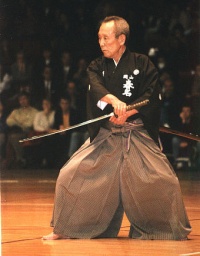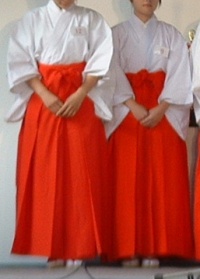Difference between revisions of "Hakama"
m |
m |
||
| (One intermediate revision by the same user not shown) | |||
| Line 2: | Line 2: | ||
{{ST|stack={{Infobox:Clothing | {{ST|stack={{Infobox:Clothing | ||
| image = Hihakama_f.JPG | | image = Hihakama_f.JPG | ||
| − | | resize = | + | | resize = 200 |
| description = A long garment of heavy hemp fabric, folded in wide pleats and covering the legs nearly to the ground. | | description = A long garment of heavy hemp fabric, folded in wide pleats and covering the legs nearly to the ground. | ||
| category = aprons | | category = aprons | ||
| Line 23: | Line 23: | ||
===== Men's Hakama ===== | ===== Men's Hakama ===== | ||
| − | The most formal type of men's hakama are made of stiff, striped silk, usually black and white, or black and navy blue. These are worn with black montsuki kimono (kimono with one, three, or five family coats of arms on the back, chest, and shoulders), white tabi (divided-toe socks), white nagajuban (under-kimono) and various types of footwear. In cooler weather, a montsuki haori (long jacket) with a white haori-himo (haori-fastener) completes the outfit. | + | The most formal type of men's hakama are made of stiff, striped silk, usually black and white, or black and navy blue. These are worn with black montsuki kimono (kimono with one, three, or five family coats of arms on the back, chest, and shoulders), white tabi (divided-toe socks), white nagajuban (under-kimono) and various types of footwear. In cooler weather, a montsuki [[haori]] (long jacket) with a white haori-himo (haori-fastener) completes the outfit. |
Hakama can be worn with any type of kimono except yukata (light cotton summer kimono generally worn for relaxing, for sleeping, or at festivals or summer outings). While striped hakama are usually worn with formal kimono, stripes in colors other than black, grey and white may be worn with less formal wear. Solid and graduated colors are also common. | Hakama can be worn with any type of kimono except yukata (light cotton summer kimono generally worn for relaxing, for sleeping, or at festivals or summer outings). While striped hakama are usually worn with formal kimono, stripes in colors other than black, grey and white may be worn with less formal wear. Solid and graduated colors are also common. | ||
| − | [[File:Hakama m.jpg]] | + | [[File:Hakama m.jpg | 200px | Male wearing hakama ]] |
===== Women's Hakama ===== | ===== Women's Hakama ===== | ||
Latest revision as of 04:12, 3 February 2018
| Interwiki |
|---|
|
български • Deutsch • English • Español • Esperanto • Français • Italiano • Lietuvių • Lojban • Nederlands • Polska • Português • Русский • Suomi • Svenska • Türkçe • 中文 |
| |||||||||||||||||||
Description: A long garment of heavy hemp fabric, folded in wide pleats and covering the legs nearly to the ground
Details:
There are two types of hakama, divided umanori (馬乗り, "horse-riding hakama") and undivided andon bakama (行灯袴, "lantern hakama"). The umanori type have divided legs, similar to trousers. Both these types appear similar. A "mountain" or "field" type of umanori hakama was traditionally worn by field or forest workers. They are looser in the waist and narrower in the leg.
Hakama are secured by four straps (himo): two longer himo attached on either side of the front of the garment, and two shorter himo attached on either side of the rear. The rear of the garment has a rigid trapezoidal section, called a koshi-ita (腰板). Below that on the inside is a hakama-dome (袴止め) (a spoon-shaped component sometimes referred to as a hera) which is tucked into the obi or himo at the rear, and helps to keep the hakama in place.
Hakama have seven deep pleats, two on the back and five on the front. Although they appear balanced, the arrangement of the front pleats (three to the right, two to the left) is asymmetrical, and as such is an example of asymmetry in Japanese aesthetics.
Men's Hakama
The most formal type of men's hakama are made of stiff, striped silk, usually black and white, or black and navy blue. These are worn with black montsuki kimono (kimono with one, three, or five family coats of arms on the back, chest, and shoulders), white tabi (divided-toe socks), white nagajuban (under-kimono) and various types of footwear. In cooler weather, a montsuki haori (long jacket) with a white haori-himo (haori-fastener) completes the outfit.
Hakama can be worn with any type of kimono except yukata (light cotton summer kimono generally worn for relaxing, for sleeping, or at festivals or summer outings). While striped hakama are usually worn with formal kimono, stripes in colors other than black, grey and white may be worn with less formal wear. Solid and graduated colors are also common.

Women's Hakama
Women's hakama differ from men's in a variety of ways, most notably fabric design and method of tying.
While men's hakama can be worn on both formal and informal occasions, women rarely wear hakama, except at formal ceremonies and for traditional sports such as kyūdō, some branches of aikido and kendo. Women do not wear hakama at tea ceremony. The image of women in kimono and hakama are culturally associated with school teachers.
The most iconic image of women in hakama is the miko or shrine maidens who assist in maintenance and ceremonies. A miko's uniform consists of a plain white kimono with a bright red hakama, sometimes a red naga-bakama during formal ceremonies.
While formal men's hakama are made of striped fabric, women's formal hakama are either a solid color or dyed with graduating hues. Hakama for young women are sometimes sparsely decorated with embroidered flowers like sakura. Women typically wear hakama just below the bust line, while men wear them at the waist.
